




















Our hearts were pounding as we slipped over the side of a shallow grotto at the edge of the Abraham's House complex.
Ron Matsen Ron Matsen
Ron Matsen
Our hearts were pounding as we slipped over the side of a shallow grotto at the edge of the Abraham's House complex. Having finished leading our 2019 B.A.S.E. Tour of Israel, Bob Cornuke wanted me to see a previously undocumented tomb in the upper Silwan area of the Mount of Olives. His investigation began in 2015 and he had often spoken of it during the intervening years. Now the time had arrived, at last, for us to examine his finding together. As we crawled through the tiny opening, we found what might be a key to unlocking a pivotal period in Jewish history.
A map of Second Temple Jerusalem and the location of various tombs. The inscription was found in the tomb highlighted by a black circle (drawn by Omri Abadi)...
33 Product Order Forms
Disclaimer: The views and opinions expressed in the articles and materials presented in this News Journal are those of the authors and/or reference sources, and do not necessarily reflect the views held by Koinonia House. While we may not agree with all the details in each article, our intention is to stimulate discussion among the Koinonia Institute membership as well as our Personal UPDATE subscribers. We encourage you to use discernment:
Acts 17:11
“These were more noble than those in Thessalonica, in that they received the word with all readiness of mind, and searched the scriptures daily, whether those things were so.”
FOUNDER
DR. CHUCK MISSLER
PRESIDENT & CEO K-HOUSE/KI
RON MATSEN
MANAGER
DAVID HANSON
EDITOR/PUBLICATIONS
DEGAN PACKWOOD
Personal UPDATE is a registered trademark of Koinonia House, Inc.. Copyright 2023. All rights reserved. Printed in the U.S.A. Personal UPDATE is published monthly for the supporters of the ministries of Koinonia House.

Editor E-mail Address editor@khouse.org
Physical Address
4055 East 3rd Avenue, Post Falls, Idaho 83854
Mailing Address
P.O. Box D, Coeur d’Alene, Idaho 83816-0347
Phone Orders/Subscriptions
1-800-KHOUSE1
(1-800-546-8731)
Office Phone: 1-208-773-6310
Fax: 1-208-773-6312
Online Subscriptions khouse.org/subscribe
Koinonia House Website www.khouse.org
Online Store store.khouse.org
Paul’s letters to the Corinthian Church reaches beyond this troubled fellowship of believers in the first century down to the modern church today. He brought to balance the issues associated with spiritual freedom and spiritual unity, discipline and love, spiritual gifts and spiritual living. He addressed the confusion of the bodily resurrection of Jesus and the future resurrection of His followers. These challenging teachings are aimed at the serious student of the Bible.
This is an Audio Only presentation and contains 27 Sessions of verse by verse teachings by Ron Matsen.


This month’s “Personal Update” news journal carries an article that I have had to wait almost four years to publish. As you will read, this was a very special discovery that took all those involved on a journey of continuous ups and downs. Finally, in January 2023, our finding was published, and now all of you will know what we found.
Many years ago, I heard it said, “In Israel, its history is being revealed and confirmed day-by-day, shovel-by-shovel.” It is exciting to think that we may have assisted the people of Israel by adding a little bit which helps to fill in their wonderful history.
May you continue to trust and rely on the unaltered Word of God.
In His Service,
Ron Matsen, President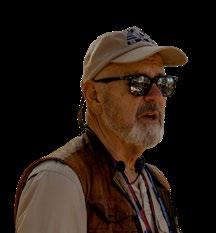


Our hearts were pounding as we slipped over the side of a shallow grotto at the edge of the Abraham's House complex. Having finished leading our 2019 B.A.S.E. Tour of Israel, Bob Cornuke wanted me to see a previously undocumented tomb in the upper Silwan area of the Mount of Olives. His investigation began in 2015 and he had often spoken of it during the intervening years. Now the time had arrived, at last, for us to examine his finding together. As we crawled through the tiny opening, we found what might be a key to unlocking a pivotal period in Jewish history.

A map of Second Temple Jerusalem and the location of various tombs. The inscription was found in the tomb highlighted by a black circle (drawn by Omri Abadi).

The Mount of Olives is the necropolis of Jerusalem. It is the oldest active cemetery in the world, to be used continuously from the Bronze Age down to the present.1 It houses many thousands of graves, including burial caves from the Second Temple period. One of them, which has not yet been scientifically excavated, is located on the grounds of “Abraham's House” (a French Catholic pilgrim’s hostel) on the southwest slope of the mountain overlooking the City of David.
Bob’s colorful recounting gives us the background story.
I was doing some research on the first century tombs around the Kidron Valley for a book I was writing. It was April 15th, 2015, when I first came across this undocumented tomb on the grounds
1 Kloner A., Zissu B., "The Necropolis of Jerusalem in the Second Temple Period," Interdisciplinary Studies in Ancient Culture and Religion; Leuven;Dudley, MA: Peeters, 2007.
of Abraham’s House. That afternoon I heard about a tomb up in the Silwan area across from the City of David. It turned out to be a Byzantine era tomb which was nothing of importance for my research, but while I was there a man, perhaps a groundskeeper, from the site told me that there was a place where they temporarily buried Jordanian soldiers during the Six-Day War in 1967. It was a “little sort of grotto” on the western boundary of the property. I asked the groundskeeper if he knew of any tombs in that location. He told me, “No, it is a natural cavern.”
After he left us, I climbed down into the “grotto” and discovered a small hole in the side of the wall. It was apparent that the recent and massive amount of rainwater had caused an opening into something behind the solid rock wall. After widening the opening, we could see that there was a large cave. We entered the cave to find four side chambers. I quickly took some pictures on my phone to document the moment. Later, when I told a friend who had worked with the IAA2 about my discovery, I was told that I was mistaken and to his knowledge there were no first-century tombs in the area of the lower Mount of Olives.
On 21 May 2019, we made the arrangements for a visit to the site with a K-House film crew to properly document the finding. We were met by
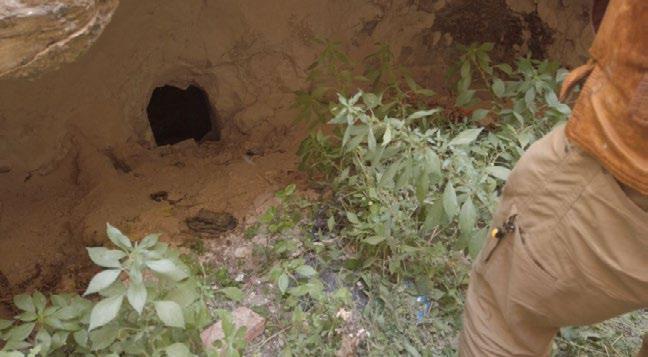
one of the workers at Abraham’s House who ushered us to the site and wished us well as we descended into the grotto. We experienced a surreal sensation as our eyes adjusted to the darkness. The yellow patina of the Jerusalem sandstone gave us a sense of the cave's age. After switching on the portable lights to allow filming, we could clearly see that the tomb had two levels with four burial chambers (kokh3) located on the upper level and one chamber accessible through a vertical shaft.


As we were carefully filming and photographing the cave, we suddenly discovered writing above one of the chambers. “It looks like Hebrew,” I shouted. Immediately all attention focused on this thrilling discovery. Our film crew rushed over with their lights and cameras knowing that this might be a once-in-a-lifetime opportunity. We captured the
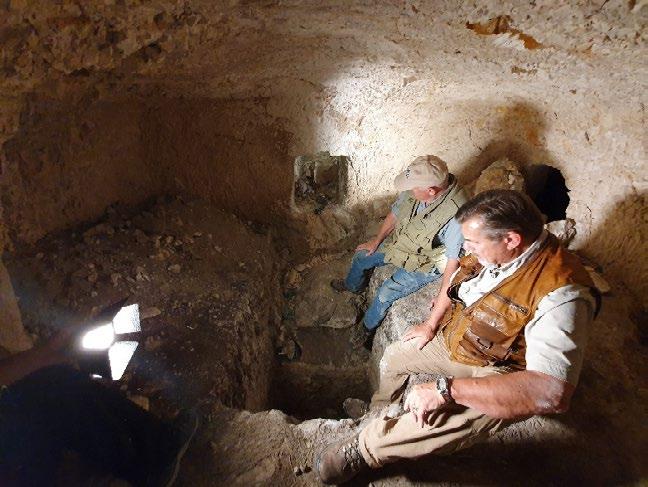


highest quality images we could, given the conditions in the cave. As our minds were pausing to take it all in, we all strongly suspected we had discovered something that very well might be significant. Time flew by as we continued our investigation. What hands left their handiwork?

What tears had been shed next to these burial chambers? What events had this small cave seen throughout its lifetime? What stories would be revealed if we were able to study this little time capsule?

That evening we collected and catalogued our images and began to contact the people we knew within the Israel Antiquity Authorities (IAA). Bob contacted his friend Eli Shukron and I reached out to Dr. Susan Hazan of the Israel Museum, Jerusalem. We were all franticly seeking a way to carry out further investigation “by the book.” Dr. Hazan passed me over to Christopher Rollston.4 Professor Rollston informed me that we should get the IAA directly involved before proceeding. In his 6 June 2019 email to me, he stated, “It's wise of you to pursue things with the IAA and to get all the paperwork in order. That makes everything nice and neat and clean, and serves everyone well. Yes, please keep me posted. If you get the paperwork in order, I would be happy to publish this with you.” Professor Rollston subsequently examined the picture of the inscription and considered it both ancient and important.
By 4 June 2019 I received my first reply from the IAA.
Dear Ron,
My name is Eran Arie and I'm the curator of Iron Age and Persian Period Archaeology in the Israel Museum. This seems an amazing find! You should be in touch with an epigraphist soon. I recommend these two epigraphists: Chris Rollston from George Washington University at Washington DC or Haggai Misgav from the Hebrew University in Jerusalem.
Good luck, Eran
With the help of Ido Garfinkel, I was able to secure the services of Haggai Misgav.
Since he has not seen the inscription itself, but only its documentation as picture and video, every conclusion in his paper is limited. The inscription message is unclear, yet the letters are, according to Misgav, consistent with Second Temple Jewish script. Its installment within a typical late Second Temple burial cave, written above one of the burial niches, strengthens this assumption.
4 He is Professor of Northwest Semitic Languages and Literatures, and Chair of the Department of Classical and Near Eastern Languages and Civilizations at George Washington University. A leading scholar in the field of Northwest Semitic epigraphy, his many research interests include ancient writing practices, scribes and scribal education, ancient literacy, the origins of the alphabet, and modern (and ancient) forgeries
The tentative reading is as follows:
תנש זומתל )?(לב סונקרוהל עשתו ןיעשת
אככ אצשתה
ןועמשל
In the following lines we present a paleographic and philological analysis of the Hebrew script, followed by the proposed translation.
Line 1: The second letter after the ב in not clear – it looks like the upper part of ק but it is doubtful whether the traces of a line to its left is still part of the letter. Alternatively, the letter could be a ל, although its upper left line is perhaps too short. Whatever that letter is, context suggests that it could well represent a number, because the next word is Tamuz (זומת) which is a name of a month in the Hebrew lunar calendar, implying that it refers to a date. ל represents the number 30, and the 30th of the month of Tamuz is a real date.5
Line 2. This line reads “ninety-nine” and with the last word of the previous line we end with “the ninety ninth year of Hyrcanus” (תנש סונקרוהל עשתו םיעשת).
Line 3. The next line is particularly hard to understand, raising more questions than solutions. It records the letter s אככאצשתה. which should probably be divided into two words: אככ אצשתה. He offered two possible readings of this line.
The root א.צ.ש. in Aramaic means “to end” or “to finish.” Rashi translates the words of Gen 43:2 ולכ רשאכ (“when they had finished [eating]”) as ואיצש דכ. The combination of letters אככ could mean “so/thus”in Hebrew. The vowel a at the end is represented by א
5 In today’s Hebrew calendar Tammuz has only 29 days, but the lunar calendar evidenced in Rabbinic literature (and probably the same calendar of second temple) was not static. Any month began when two witnesses had seen the new moon, that is on either the 30th or the 31st day, and each month could have either 29 or 30 days. For a detailed description see J. C.VanderKam, Calendars of the Dead Sea Scrolls: Measuring Time (Abingdon: Routledge, 1998): 27-29.
rather then ה (perhaps influenced by Aramaic). A full translation of the line could thus be “will it end thus?” We will have more to say on this below.
Line 4. The last line only records one word: ןועמשל meaning: “for Simon.” Simon was the most common male Jewish name in the Second Temple period, particularly in the Hasmonaean times.6
Proposed translation:
ˏ Line 1: On the ל (30th) of Tammuz, year
ˏ Line 2: ninety and nine of Hyrcanus
ˏ Line 3: Will it end thus
ˏ Line 4: for Simon?
As soon as we had the first rough translation, our “investigator engines” kicked into overdrive. We quickly put together a video and began to spread it around to anyone we thought could help us gain approved access to explore more deeply. After a few email exchanges with the IAA we set a date of 18 July 2019 to meet up and officially go to the site. During our flight back to Israel, I was assuring myself that “all the boxes had been ticked,” so we should be well on our way to an amazing experience!
The day following our arrival we decided to travel to Abraham’s House to scout around the entire compound. We introduced ourselves at the main desk and asked for a tour of their facilities. After an hour or so of walking round we decided to stay and have lunch in the restaurant. Everyone was courteous and friendly. We then had a preparatory meeting at our rented accommodations with officials of the IAA on 16 July to show them more of the film footage we had captured from inside of the tomb on 21 May 2019. There was the sense of electricity filling the room as we discussed the possible outcome of an investigation of this site. All was now set to go.
The morning drive around the Old City of Jerusalem then up the slope of the Mount of Olives was filled with the unusual sound of firecrackers going off all around the Kidron Valley. “Sounds like a war going on,” Bob said. We would later find out that it was some type of Palestinian protest in the local neighborhood. The gates of Abraham’s House swung open as we drove through the large rock-walled entrance which welcomed us onto this beautiful pilgrim’s sanctuary. We met up with our Hebrew guide Ido Garfinkel and Epigraphist Haggai Misgav.
Shortly after our arrival the representatives of the IAA drove into the compound in their official vehicles. I was introduced to the Chief Archeologist of Jerusalem as we walked into the lobby. “Hi, we are here to view a tomb as a possible site of interest,” I said. Immediately a dark figure stepped out from behind the door and replied, “You are not going anywhere. Get out of here.” Shocked, I quickly deferred to the IAA officials and took a step back as a heated conversation in Arabic ensued.

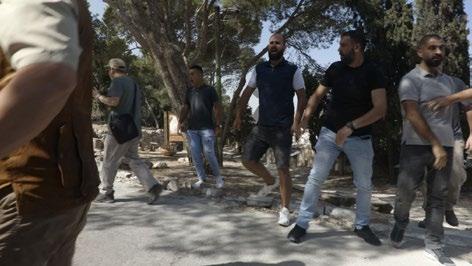
Bob, Ido, Haggi, Ben (our videographer) and I moved to the outside patio and watched the drama unfold in front of us. After more than 30 minutes of conversations oscillating in intensity, the IAA officials announced that they were waiting for the police to arrive. As we moved in the direction of our parked cars, two cars sped into the compound carrying more than a dozen local Palestinian men who quickly formed a line and began violently forcing us back down the narrow-walled entrance that had welcomed us before. The Police eventually arrived, more shouting continued, and nothing was accomplished in our favor. Finally, the IAA official came over to me and said, “Sorry, but this site is now closed forever.”
Eventually, the Abraham’s House guards allowed us to retrieve our cars, and we drove away dejected and pondering our next steps. Did we almost create an international incident? Could we have sparked a wider rebellion? For a paralyzing few moments I think we understood what it means to live in place where violent escalation is only one wrong decision away. In the face of defeat, we retreated to our accommodations.
As we flew home to an uncertain future for this project, we all knew that it could not just end here so abruptly. After weeks of reflection, I decided to write to the École Biblique et Archéologique Française in Jerusalem (a French Roman Catholic Archaeological Society). As Abraham’s House was connected with the French Roman Catholic Church, I thought maybe archeologists within this society would understand and ultimately assist us in gaining access to the tomb. Surely the photographs would be a tempting morsal for an inquisitive explorer.
The response we received from this world-renowned society shocked me. “Upon viewing the photographs, we have determined that the inscription was a modern forgery and then also that it had subsequently been defaced.” My blood ran cold as I considered the implication of this dreadful news. Did we cause a two-thousand-year-old inscription to be wiped out by an angry hammer? Did our clumsy handling of this
Finally, the IAA official came over to me and said, “Sorry, but this site is now closed forever.”
priceless find cause it to be lost forever? The weight of these horrible thoughts overwhelmed me with regret. At this point I felt the rise of a strange intestinal resolve to “never do this again.”
“Snatching victory from the jaws of defeat” is a quote often used to describe an event when the underdog triumphs against all odds. As the next few months passed, I had time to take stock of what we had and what might be done with it. To casually post it on Facebook or make a short YouTube video didn’t seem to hit the target as far as I was concerned. Our list of options began to grow as did our renewed excitement that this discovery could still make an impact. We had collected:
1) Many high-quality photographs and videos of the tomb.
2) An ancient inscription that has been reliably translated.
3) An inscription that mentions the names of two leaders during the Hasmonean period.
4) A historical narrative that could fill some gaps in the Second Temple Period history of Israel.
5) Some high-level experts within the archaeological community that have expressed interest in helping us get this discovery out to the world.
With these tools in our toolbox, we decided to press ahead and produce a document that would be worth publishing to the world of archaeological experts.
First and foremost, it should be emphasized that both Misgav and Rollston consider this inscription to be ancient, the (casual) comment of some at the Êcole Biblique notwithstanding. Christopher Rollston noted that some genuine ancient inscriptions can and do surface on the antiquities market. That is, not everything on the antiquities market is a modern forgery, but it is common for modern epigraphic7 forgeries to ‘surface’ on the antiquities market, after an important
epigraphic discovery (of an actual ancient inscription).8 However, our inscription did not appear in the antiquities market, and its content is not reminiscent of some recent epigraphic discovery at an excavation. Furthermore, and of particular importance, there are no paleographic or orthographic anomalies9 in this inscription. And the inscription remains (at least at the time of our photographs) in situ, or in place. In sum, current evidence supports the conclusion this is an authentic ancient inscription.
Does the inscription refer to Hyrcanus II? The name Hyrcanus was not especially popular in the Second Temple period, and appears on record some eleven times, most of them Hasmonean or their dependents.10 Ilan identified it as a Persian name, based on the region “Hyrcania” in central Asia. Note that Machiela has contended that the name was originally Egyptian.11 The first Hyrcanus on record is the son of Joseph, son of Tobias who was active in Ptolemaic Egypt in the second century BC.
The most famous contenders to the name are the two Hasmonean rulers: John Hyrcanus I, and Hyrcanus II. It would seem reasonable to infer that the inscription refers to one of these Hasmonean rulers, based on the numeric reference in the inscription to a year of “Hyrcanus,” which would be most consistent with that used for a “ruler” (priestly or political). The first Hyrcanus was known by his Hebrew name John (ןנחוי) and is usually referenced in this way, with his title “high priest” (לודג ןהכ, in the Hebrew sources, such as his coins12 (לודג ןהכ ןנחוי) and rabbinic literature (“לודג ןהכ ןנחוי”e.g., M. Ma‘as. Š. 5:15; T. Sota 13:5). Hyrcanus II is referred to only as Hyrcanus, both in Greek by Josephus13 and in Hebrew within rabbinic literature (“סונקרוה”-B. Sota 49b; B. B. Qam. 82b; B. Menah. 64b). For this reason alone, we conclude it is more likely
8 C. Rollston, “Forging History: From Antiquity to the Modern Period.” in Archaeologies of Text: Archaeology, Technology, and Ethics (Institute Publication Series of Brown University; eds. M. Rutz and M. K. Joukowsky; Oxford: Oxbow Books, 2014): 176-197.
9 No irregularities in the way letters were formed, nor the construction of words and sentences of that period.
10 Ilan (N 7): 350-351.
11 D. A. Machiela, “A Brief History of the Second Temple Period Name ‘Hyrcanus’,” JJS 61 (2010): 117-138.
12 Y. Meshorer, A Treasury of Coins (Jerusalem: Ben Zvi Publications, 2001): 31–32.
13 Mentioned often in A.J. 14-15 and the B.J. 1, see D.R. Schwartz, “Josephus on Hyrcanus II,” in Josephus and the History of the Greco-Roman Period (Studia post-Biblica 41; ed. F. Parente and J. Sievers; Leiden: Brill, 1994): 210–232.
the inscription refers to Hyrcanus II, and not his grandfather who was better known as “John Hyrcanus” or simply “John the high priest.”14
Hyrcanus II was born in 110 BC, the firstborn son of King Alexander Jannaeus (יאני) and Queen Alexandra Shelamzion ( ןויצמולש). During his mother’s reign, Hyrcanus officiated as high priest (Josephus B.J. 1.109; A.J. 13.408). Upon her death in 67 BC, the queen intended that Hyrcanus should succeed her as monarch and continue to hold the office of high priest that he had occupied since his mother became queen (Josephus B.J. 1.120). That, however, was not to be, for his younger brother Aristobulus II, who was in command of the army, believed he should be the next king of Judea (Josephus B.J. 1.121–122).15 The endless strife between the brothers led to civil war, and they both applied for help from the Roman general Pompey the Great, who arrived at this time in the eastern Mediterranean.16

Pompey conquered Jerusalem, deposed Aristobulus II, and appointed Hyrcanus II as a puppet ethnarch (not king) of Judea, also restoring him to the position of high priest in the Temple (Josephus B.J. 1.128–153). This was the beginning of Roman rule over the land, which ended with the Islamic conquest some seven hundred years later.
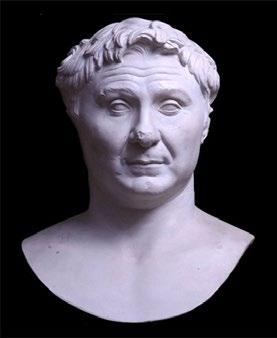
14 More on how persons mentioned in epigraphic records can be identified with a person mentioned in literary sources see J. L.Mykytiuk, Identifying Biblical Persons in Northwest Semitic Inscriptions of 1200-539 B.C.E. (Atlanta: SBL Press 2004): 9-56, and specifically for the relevant time period of Hyrcanus see T. Ilan, “Julia Crispina Daughter of Berenicianus, A Herodian Princess in the Babatha Archive: A Case Study in Historical Identification,” JQR 82 (1992): 362-368.
15 Cf. M. Orian, “Hyrcanus II versus Aristobulus II and the Inviolability of Jerusalem,” JSQ 22 (2015): 205-242.
16 K. Atkinson, “The Case for Hyrcanus II as the “Wicked Priest” and a Pirate: Evidence from a Neglected Roman Historical Source,” The Qumran Chronicle 27 (2019): 42-51.
The real power behind the throne was in the hands of Hyrcanus’ advisor Antipater, son of one of the Idumeans who were forcefully converted to Judaism by John Hyrcanus I (Josephus A.J. 13.257–258). Antipater was the father of Herod, who was destined to become a great king himself. In 40 BC, war broke out with the Parthians (Persians), who temporarily appointed Antigonus II Mattathias, the younger son of Aristobulus II, as king. Hyrcanus II was taken prisoner, his ears and nose were cut off, ensuring that he could no longer serve as high priest, and he was carried off into exile in Babylonia (similarly to the Biblical King Zedekiah in 2 Kings 25:7). Herod escaped with his life and returned with a Roman army to reclaim the throne in 37 BC. A year later he requested that Hyrcanus II travel back to Jerusalem from Babylonia, only to accuse him of treason and ingloriously execute him in 30 BC, at the age of 80 (Josephus B.J. I.433; A.J. 15.165–173).17

The type of burial cave fits the Herodian period, the time in which Hyrcanus II was put to death.18 It is also not surprising that Hyrcanus was not buried in a royal tomb, for he was at this point a persona non grata in the eyes of Herod the Great. Nevertheless, a burial of some sort was called for. Therefore, a rock-hewn cave in the Jerusalem necropolis on the Mount of Olives would seem a reasonable place for him to be buried. It seems that the aged Hyrcanus still had some supporters who longed for a Hasmonean revival. The provision of a decent burial for one of the last Hasmoneans should come as no surprise.
17 In general, see E. Schürer, G. Vermès, and F. Millar, History of the Jewish People in the Age of Jesus Christ, vol. 1 (Edinburgh: T. & T. Clark, 1973): 257–280; E.M. Smallwood, The Jews Under Roman Rule: From Pompey to Diocletian: A Study in Political Relations (Leiden: Brill, 1981), 64; On Herod and Hyrcanus see P. Richardson, Herod: King of the Jews and Friend of the Romans (Columbia SC1: Routledge, 1996), throughout. On the character of Hyrcanus II see Schwartz (N 13).
18 Kloner and Zissu (N 1).
The second line of the inscription mentions the year “ninety and nine of Hyrcanus.” What happened ninety-nine years after some event associated with this person? Hyrcanus II was crowned in 67 BC, and ninety-nine years later would be the year AD 32, to which we see no significance. However, when counting ninety-nine years from Hyrcanus’ death in 30 BC, this would be year AD 69, exactly one year before the destruction of the Temple by Titus in AD 70. In this last year of the Second Temple era the war between the Jews and the Romans had raged for three years. Jerusalem was in the grip of zealots of all stripes, with Simon bar Giora’s faction perhaps the most dominant among them. (Josephus B.J. 7.262273, on Simon Bar Giora specifically see 265-266). Moreover, it was the Year of the Four Emperors, which rocked the Roman Empire and was destined to end with Vespasian gaining the throne.19 His coronation marked the “final judgment” on the Jewish rebellion—suppressing it had been his main goal for the last two years and, now that he was in power, he intended to bring it to a close. His son, Titus, would accomplish this mission. Perhaps, shortly before the siege began, certain Jews came to this cave, perhaps the tomb of Hyrcanus II, and inscribed on its wall a message that was significant to them. This would be in keeping with some of the content of some ancient Jewish burial graffiti, as discussed by Karen Stern.20
Who is Simon? The second person mentioned in Line 4 is Simon. He is associated with the words ןועמשל אככ אצשתה, that is, “will it [also] end so for Simon?” In the year AD 69, Simon bar Giora was the leader of the largest faction in Jerusalem fighting against Rome and was identified by the Romans themselves as the ringleader of the revolt. Could this inscription be a graffito, cursing Simon bar Giora, and wishing him a similar fate to that suffered by Hyrcanus II ninety-nine years earlier? It is of some interest that in AD 71 Simon bar Giora was indeed brought to Rome and publicly executed in Titus’ triumph (Josephus B.J. 7.153–154), fulfilling the expectation voiced in our inscription.
19 See for example B. Levick, Vespasian, (London and New York: Routlrdge, 2017): 49-74. 20 K. Stern, Writing on the Wall: Graffiti and the Forgotten Jews of Antiquity (Princeton NJ: Princeton University Press, 2018): 140.
It is worth noting that another graffito recording a curse was found at Gezer and dated to the second half of the second century BC, after Gezer’s conquest by the Hasmoneans (142 BC). This is a short graffito bearing the words: “[Says] Pampras; May fire devour Simon’s palace.”21 This Simon, incidentally, was the great grandfather of Hyrcanus II.
This new Second Temple inscription from Jerusalem mentions two persons: Hyrcanus and Simon. The readings and translation of this inscription are fairly straightforward, but the precise interpretation of the content is difficult. We cautiously suggest a possible understanding of this inscription; it is a curse mentioning two historical figures, articulating the wish that the fate of Simon (bar Giora) be the same as that of Hyrcanus II (i.e., execution for treason).
The core of this article was prepared for formal publishing with MAARAV - A Journal for the Study of the Northwest Semitic Languages and Literatures.22 Our thanks go to Ido Garfinkel23 for his in-depth research and core document composition.
Thanks to Mr. Haggai Misgav of the Institute of Archeology, The Hebrew University of Jerusalem. Thanks to Yosef Garfinkel, the Yigael Yadin Chair in Archaeology of Israel at the Hebrew University of Jerusalem24 for his guidance and editorial input. Thanks to Professor Christopher Rollston, Professor of

Northwest Semitic Languages and Literatures, and Chair of the Department of Classical and Near Eastern Languages and Civilizations at George Washington University25 for being willing to publish our finding.
After more than three years of waiting, MAARAV published our article in their January 2023 edition. Praise the LORD!
25 https://www.biblicalarchaeology.org/scholar/christopher-rollston/


$66.85
Sale Price: $39.95
Includes: Temple; Golgotha; Search for the Ark of the Covenant; and The Lost Shipwreck of Paul



The Cornuke Book Bundle AVAILABLE
on our online store: store.khouse.org
A former police investigator and SWAT team member, Bob Cornuke is a Biblical investigator, international explorer, and author of nine books. He has participated in over sixty expeditions around the world searching for lost locations described in the Bible. These journeys include searching for Mount Sinai in Egypt and Saudi Arabia, looking for the remains of Noah’s Ark in Turkey with astronaut Jim Irwin (the eighth man to walk on the moon) and researching ancient Assyrian and Babylonian flood accounts in Iran.
Products available from http://store.khouse.org
Available from store.khouse.org
Paul’s letters to the Corinthian Church reaches beyond this troubled fellowship of believers in the first century down to the modern church today. He brought to balance the issues associated with spiritual freedom and spiritual unity, discipline and love, spiritual gifts and spiritual living. He addressed the confusion of the bodily resurrection of Jesus and the future resurrection of His followers. These challenging teachings are aimed at the serious student of the Bible.
This study contains 27 Sessions of verse by verse teachings by Ron Matsen.

This subject has not gone away. On the contrary, much new evidence has surfaced with global implications. Chuck explores the Biblical relevance and disturbing agenda of the apparent extraterrestrial life forms that have been forcing themselves into our global consciousness and reveals their most disturbing agenda.

What's behind the UFO's? • Are they real? • Where are they from?
Are they the Nephilim of ages past? • What does the Bible say about them? What's their agenda for Planet Earth?
"For there shall arise false Christs, and false prophets, and shall shew great signs and wonders: insomuch that, if it were possible, they shall deceive the very elect." (Matthew 24:24)
How do you protect yourself?
This study confronts the issues head-on and offers answers to many of the most pertinent questions, including a chapter on government disinformation and possible cover-ups.
Chuck Missler deeply believed that the Church in the end times would need to be “self-feeders.” In his teaching series on the Once and Future Church, Chuck emphasized the fact that the best place to practically learn the Bible is within a small group of believers who are all dedicated to taking the Bible seriously. To help facilitate this vision, Koinonia House has prepared another complete study group tool kit! Just add a group of people excited to explore the book of Revelation, and you have all you need to start your group NOW!
The Revelation Group Study Package materials are all contained on a handsomely presented USB drive that is housed in an engraved wooden presentation box which includes:

• Revelation Remastered HD MP4 video files (24 High Definition Videos)
• Revelation MP3 audio files (All 24 audio files)
• Revelation Handbook - PDF (Supplemental Notes by Chuck Missler)
• Revelation Group Leader’s Guide – PDF (“How to lead a group” instructions, Session Questions Answer Key, Group Discussion Questions)
• Revelation Student Study Guide – PDF (Session Questions, Discussion Topics and areas for Personal Notes)
• Chuck's Remastered Power Point files
The complete collection of handbooks, containing supplemental notes for Chuck Missler’s Commentary series, Genesis to Revelation.*

Available in the following formats:
Handbook (paperback study notes): Complete set of 44 Printed Commentary Handbooks (Paperback)
Handbook (pdf download):
The complete set of Commentary Handbooks (PDF Download) Now single page format
Numbered and clickable Table of Contents
Bookmark (left) menu for quick navigation ORDER
Available from our store at store.khouse.org
* Note: Handbooks are already included as digital files or downloads with their respective commentary DVD, Audio CD, MP3 CD, Audio and Video download products.)


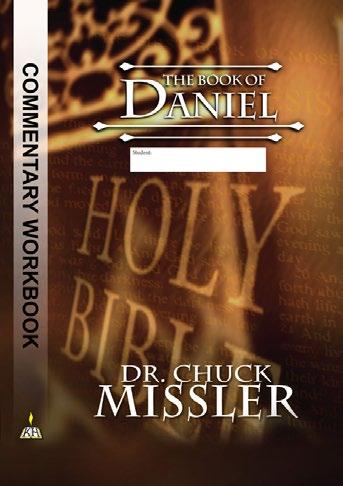


*plus shipping and handling


Koinonia Institute is an online Bible Institute with a focus on verseby-verse study where serious Christians can grow in knowledge, understanding, awareness and commitment!


Here at KI, we delve into the relevance and reliability of Scripture, and help you focus on discovering God’s call on your life.
Whether you have years of Bible training or are just beginning your spiritual journey, the curriculum here will challenge you to see the harvest and ask the Lord of the Harvest to send you into His fields (Matthew 9:37-38).
JOIN
Mark Titles Below And Add Total To The Summary At The Bottom Of This Page.
Topical Studies by Chuck Missler on CD or DVD - For Download Pricing visit store.khouse.org
All prices in U.S. dollars, correct at time of printing and may be subject to change.
See also our online store: https://store.khouse.org
All prices in U.S. dollars. See also our online store: https://store.khouse.org For Australia and New Zealand, go to: https://khouse.org.nz
NOTE: Mixed Format Collection includes all available Old Testament Commentary DVDs, PLUS the remaining Audio Only Old Testament Commentaries on MP3 CD-Rom in a single collection!
All prices in U.S. dollars, correct at time of printing and may be subject to change.
See also our online store: https://store.khouse.org
The Cornuke Book Bundle - The Search of the Lost Shipwreck of Paul (hardback), Golgotha (paperback), Temple (paperback), and Search for the Ark of the Covenant (paperback).
The Chuck Missler Big Book Bundle: Enjoy 3 of Chuck Missler’s big books in one bundle: I, Jesus; Alien Encounters; and Cosmic Codes!
Chuck Missler Small Book Collection (Paperbacks Included: Angels Volume I, Angels Volume II, Behold a Black Horse, Behold a Livid Horse, Behold a White Horse, Behold a Red Horse, Beyond Coincidence, Beyond Newton, Beyond Perception, Beyond Time & Space, Daniel’s 70 Week’s, Footprints of the Messiah, Hidden Treasures in the Biblical Text, How We Got Our Bible, Israel and the Church, The 7th Day, The Christmas Story, The Feasts of Israel, The Fulcrum of the Entire Universe, The Origin of Evil, The Rapture, The Romance of Redemption, The Spiritual Gifts, The Trinity, How to Study the Bible.)
Daniel: Group Workbook Pack - DVD + 6 Workbooks and Leader's Guide
* NEW *
Daniel Study Set (DVD, Handbook, Workbook) * NEW *
Deuteronomy DVD plus FREE Handbook (paperback)
The Four Horsemen Paperback Bundle (White, Red, Black and Livid Horse)
- 10 Pack
All prices in U.S. dollars, correct at time of printing and may be subject to change.
See also our online store: https://store.khouse.org
All prices in U.S. dollars. See also our online store: https://store.khouse.org For Australia and New Zealand, go to: https://khouse.org.nz

The Bible is the very Word of God, is inerrant in its original autographs, and is fully and totally and uniquely reliable as the primary guide to all actions and commitments; That Jesus Christ is God Incarnate, became man to fulfill a destiny on our behalf, was crucified, buried, and bodily resurrected, is presently seated on His Father’s Throne, and will soon return to establish His Kingdom on the Planet Earth. That, in the meantime, the Holy Spirit is uniquely active in pursuing His mission in calling, equipping, and empowering believers, and is essential for any and all of the pursuits to be fruitful and effective.
…is a New Testament word which is most often translated to mean “communication,” “fellowship,” or “communion.” Koinonia House, or K-House as we are affectionately called, is dedicated to the development and distribution of materials for encouraging and facilitating serious study of the Bible as the inerrant Word of God. We are a non-profit, 501(c)3 organization.